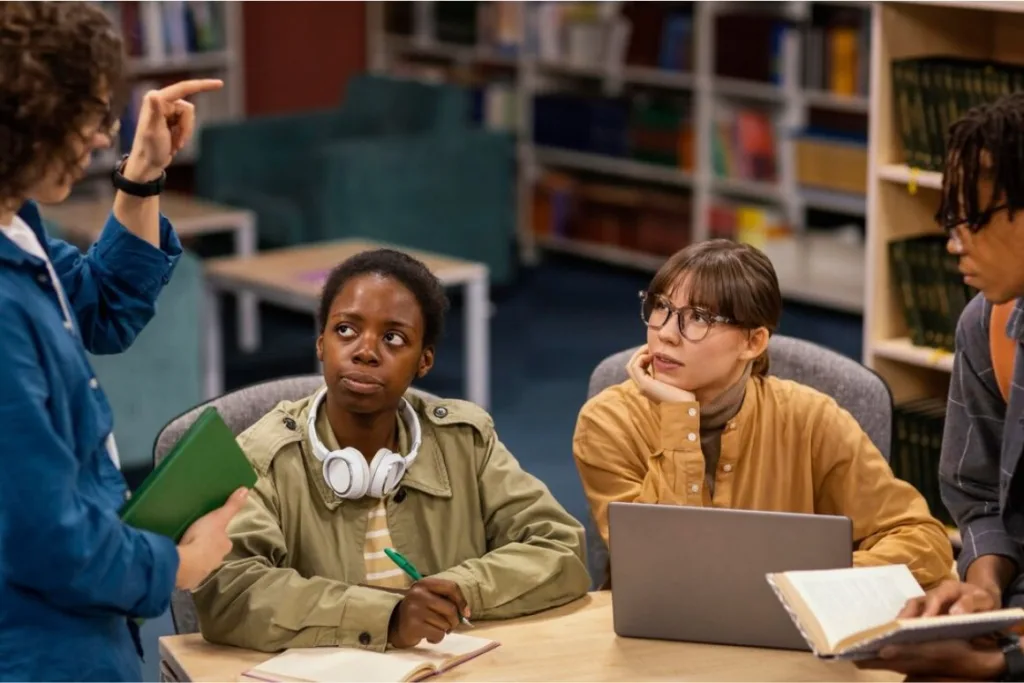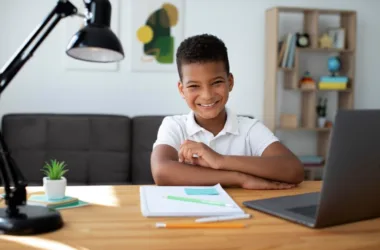Have you ever wondered when is the best time and age to introduce coding to your kids? You’re at the right place.
According to research, the brain is more receptive to learning and has the most flexibility between childhood and adolescence. This may make it simpler for kids to acquire new skills like coding.
In this comprehensive guide, you will discover what your kids should learn at every single stage of their coding journey from preschool to high school.
What’s the Best Age For Kids To Start Coding?
There’s no single “best” age for kids to start coding, but research suggests that early exposure offers significant benefits.
While a child’s individual development plays a role, experts generally recommend introducing basic coding concepts between the ages of 5 and 7.
At this stage, MIT suggests using tools like ScratchJr, which leverages games and logic puzzles to make learning fun and engaging.
The key advantage of early exposure is the brain’s heightened plasticity during childhood. This essentially means the brain is more receptive to forming new connections, making it easier to learn new skills like coding.
However, it’s important to remember that neuroplasticity continues well into adulthood. So, even if a child doesn’t start at a young age, consistent practice can still lead to significant learning.
The most important factor is finding the right approach based on your child’s age and interests.
Whether you start with unplugged activities or age-appropriate coding platforms, focus on making it a fun and rewarding experience.
Now, let’s take a good look at the various milestones and age groups from Preschoolers to high Highschoolers and what they should be learning at each stage;
Preschool Age

While preschoolers might not be writing complex code, these early years are important for laying the groundwork for future success.
Here’s what they can learn;
- Sequencing: Activities like arranging blocks in a specific order or following a recipe introduce the concept of order and step-by-step thinking.
- Pattern Recognition: Identifying patterns in toys, games, or even nature helps children develop problem-solving skills and logical thinking.
- Spatial Reasoning: Coding heavily relies on spatial concepts. Games and activities that involve manipulating objects in space can prepare children for this aspect of coding.
- Basic Commands: Through play and interaction with toys or games, children can grasp the idea of giving instructions and seeing results.
Primary School Age

Primary school-aged children (7-10 years old) are like sponges, eager to learn and develop new skills. This is the perfect time to introduce them to the exciting world of coding in a more structured way. Here’s what they can start learning:
- Basic Programming Concepts: Visual programming languages with drag-and-drop features are ideal for this age group. These platforms allow children to learn about loops, conditionals (if/then statements), and functions in a fun and interactive way.
- Algorithmic Thinking: Coding is all about breaking down problems into smaller, manageable steps. Through age-appropriate activities, children can develop this crucial skill, which is applicable to many aspects of life.
- Debuggng: iEven simple programs can have errors (bugs). Learning how to identify and fix these bugs fosters perseverance and problem-solving skills.
- Computational Thinking: This involves approaching problems in a logical and methodical way, a valuable skill that coding helps develop.
- Introduction to Coding Terminology: Familiarizing children with basic terms like variables, functions, and loops lays the groundwork for understanding more complex concepts later on.
- Storytelling and Creativity: Many coding platforms for this age group allow children to create simple animations or games. This encourages them to combine coding with storytelling and express their creativity in a digital format.
Middle School Age

Middle schoolers (11-13 years old) are at a pivotal stage in their cognitive development. Their logical thinking and problem-solving abilities are solidifying, making them ready to tackle more complex coding challenges. Here’s what they can delve into:
- Text-Based Coding Languages: The transition from visual programming to text-based languages like Python or Javascript opens doors to a wider range of possibilities. This allows for more control and flexibility in creating programs.
- Object-Oriented Programming (OOP): This fundamental programming concept teaches students how to organize code into reusable blocks, making it easier to build larger and more complex projects.
- Data Structures and Algorithms: Understanding how data is stored and manipulated is essential for efficient coding. Middle school is a good time to introduce basic data structures like lists and arrays, along with fundamental algorithms for sorting and searching.
- Problem-Solving and Critical Thinking: Coding projects in middle school can become more intricate, requiring students to break down problems into smaller steps, identify errors, and debug their code. This fosters critical thinking and problem-solving skills.
- Project-Based Learning: Middle school is a great time to encourage project-based learning. Students can work on projects that interest them, like building games, simulations, or even simple websites. This not only reinforces coding skills but also promotes creativity and independent learning.
High School Age

High school (14-18 years old) is where coding education can truly take flight. With a solid foundation in place, teenagers can explore advanced topics, specialize in areas of interest, and potentially build impressive portfolios for future endeavors. Here’s what high schoolers can achieve:
- Advanced Topics: The possibilities are vast! Students can delve into web development, mobile app development, game design, cybersecurity, artificial intelligence, or even data science.
- Specialization: By focusing on a specific area like web development or game design, teenagers can develop a deep understanding of the tools and technologies used in that field. This can be a valuable asset when pursuing higher education or future careers.
- Project-Based Learning on Steroids: High school coding projects can become substantial undertakings, allowing students to showcase their skills and creativity. Building complex games, functional websites, or even mobile apps can be incredibly rewarding and create a strong portfolio for college applications or job hunting.
- AP Computer Science Courses: For highly motivated students, Advanced Placement (AP) Computer Science courses offer college-level curriculum, providing a significant advantage in college admissions and potentially earning college credit.
- College Preparation: A strong foundation in coding can be a major asset for college applications, especially for science, technology, engineering, and math (STEM) programs.
- Career Exploration: Coding skills are becoming increasingly valuable across various industries. By exploring different areas of coding in high school, students can gain valuable insights into potential career paths.
How to Start Coding for Kids?
When starting out, overcommitting yourself or moving too quickly may lead to frustration. If you want them to benefit from learning to code, you want them to love the process.
It’s best to take your time, begin coding gradually, and reach little milestones along the way.
In order to help your kids learn and love coding, here’s a brief explanation of how to accomplish it:
1. Start with the fundamentals and guide them.
Finding the fundamentals difficult to understand makes learning a new skill difficult. Engaging your kids in some light reading or watching is the finest approach to demonstrate the joys of coding.
Look for resources on coding fundamentals in books, articles, or even YouTube videos.
After learning the fundamentals of coding, kids will be able to briefly describe it to friends and family. You could even wind up learning anything if you’re not acquainted with coding.
2. Get a little more information
You can really help anything new stay in your mind by discussing it with others. Motivate your kids to discuss this topic with their friends.
Your child might be able to explain how coding is necessary for the creation of the video game they are now playing, for instance.
They might ask about how code powers robots from their science instructor at school.
There’s a chance that none of the people your kids hang out with on a daily basis are interested in programming. You will have to venture a little in this case. Take the kids to an after-school group that explores coding, or take them to a technological museum.
Their knowledge of coding could be improved here, and they can converse with like-minded others about it.
3. Try something small
When learning anything new, going overboard is one of the greatest errors individuals do. Coding is the foundation of video games, robotics, and movies, as your kids have lately discovered. Which is great since they’re eager to learn more.
Making the next combat bot or open-world adventure game shouldn’t be their first endeavor, however. Keep their initial expectations reasonable even if anything is conceivable.
Instead, let your kids begin with a little activity.
So, before delving further into it, students may have a sense of what coding is like.
Starting with basic mobile applications like Move the Turtle or online learning tools like Scratch is highly recommended. Bookings for our summer program on scratch coding are being accepted right now.
In addition to providing opportunities for enjoyment, these two resources will facilitate the process of learning to code.
4. Go on to something more ambitious
Your students are ready to move on to greater and better things now that they have mastered the fundamentals. Recall that while they shouldn’t be aiming for the stars just yet, they are prepared to continue on their adventure.
Stay with what you know they are used to.
Their understanding of how various components join together to create something will be aided by this. Maybe students make an online game or a comparatively basic mobile app; in fact, this is a fundamental goal for many of our summer coding programs.
There is no limit to the possibilities.
You can also read our more detailed guide on the Best Ways to start Coding for Kids.
Final Thoughts
As we’ve seen in this guide, you can start teaching your kids coding as early as 5 – 7 considering their brains are being developed and is prone to receive and capture new skills and concepts quickly and well.
Your kids in preschool just as we discussed in above should get started with some coding like sequencing, pattern recognition, basic commands etc.
They can then move on to higher concepts and activities as the grow up to their Highschool level.
Most importantly, don’t forget that one of the best things you can do for your kids learning coding is to keep their journey fun and engaging. You can kindly read our guide on how to do so here.






